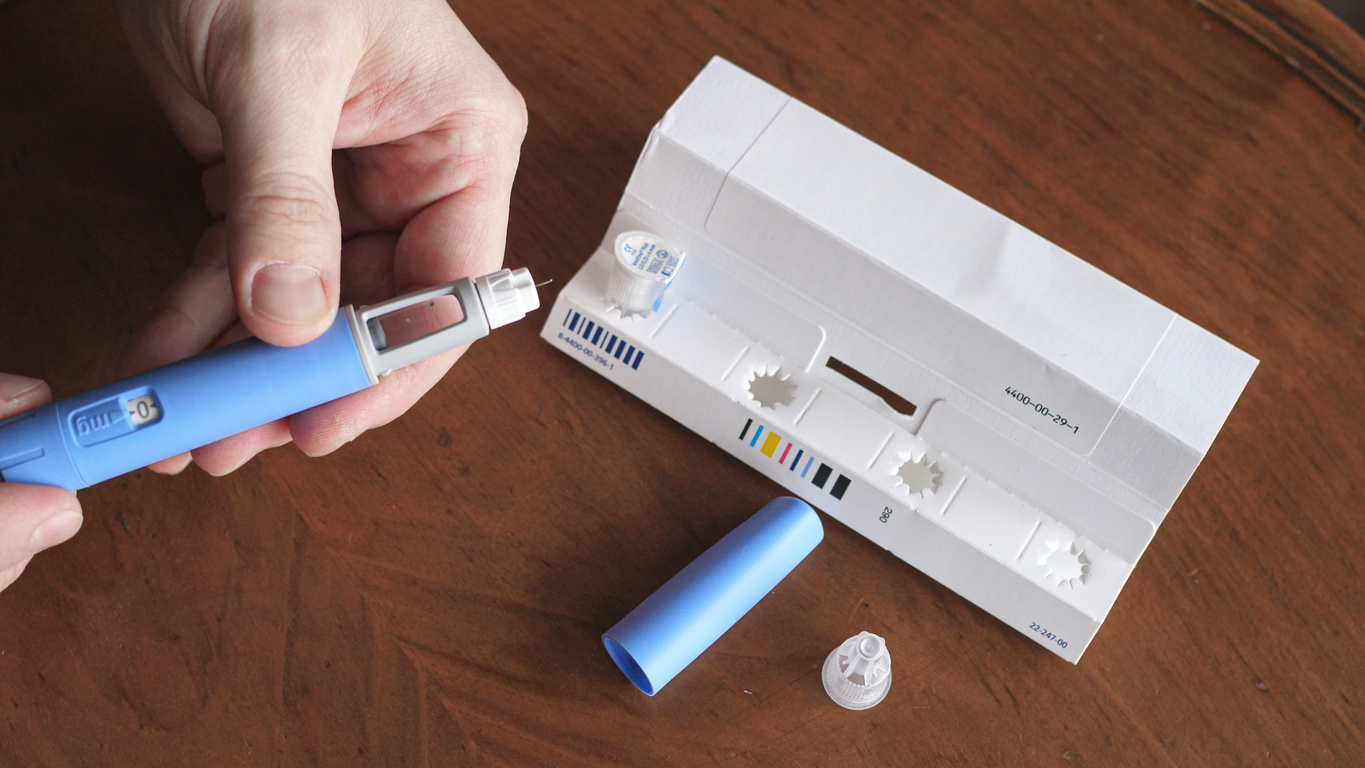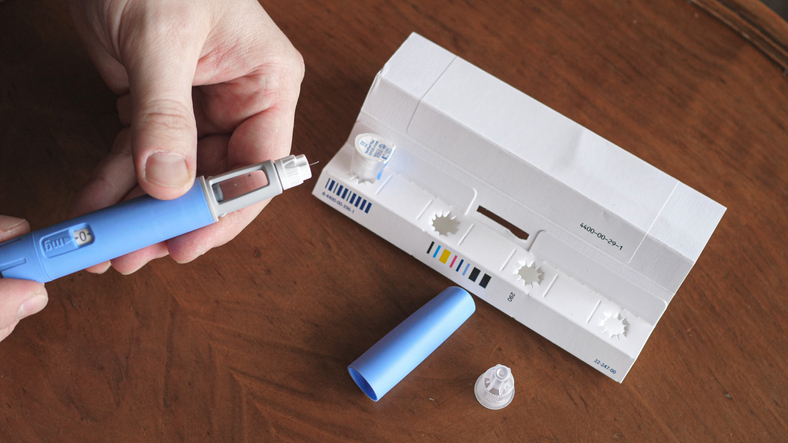Everything you need to know about Saxenda Weight Loss

What is Saxenda?
Liraglutide, the active ingredient in Saxenda weight loss, is used to help obese or overweight individuals who also have weight-related medical issues lose weight and help keep the weight off once it has been lost. When a youngster is obese and weighs more than 132 pounds, between the ages of 12 and 17, Saxenda may be utilized (60 kg). Saxenda is used along with a balanced diet and regular exercise.
Saxenda weight loss injections are administered once a day through a multi-dose injection pen.
Liraglutide is the same active component in Saxenda as it is in Victoza. Victoza and Saxenda differ in that they are FDA-approved for certain conditions but have varying strengths.
Diabetes type 1 or type 2 cannot be treated with Saxenda. Saxenda’s safety and effectiveness in kids under the age of 12 are unknown. Saxenda’s safety and efficacy in type 2 diabetic youngsters aged 12 to 17 is unknown.
How does Saxenda work?
Saxenda injection acts to promote weight loss by suppressing appetite, slowing stomach emptying which makes you feel full for longer and so you decrease your calorie consumption. Saxenda resembles a hormone that the body naturally produces and that aids in regulating digestion, insulin levels, and blood sugar levels. Saxenda is a member of the group of drugs known as glucagon-like peptide-1 (GLP-1) agonists.
Saxenda has received FDA approval for both weight loss and maintenance of weight loss. It is suitable for:
- Adults that are obese (BMI 30 kg/m2 or higher)
- Those with a BMI of 27 kg/m2 or higher who additionally have weight-related health issues, such as hypertension, type 2 diabetes, or dyslipidemia.
- Children over the age of 12
- Per international cut-offs, adults who have a body mass index (BMI) greater than 30 kg/m2 and a starting weight of above 60 kg are considered obese (Cole Criteria)
Warnings
Liraglutide under the Victoza brand name is used to treat type 2 diabetes together with diet and exercise. Victoza and Saxenda should not be taken together.
If you have multiple endocrine neoplasia type 2 (glands tumors), medullary thyroid cancer in your family or personal history, insulin-dependent diabetes, diabetic ketoacidosis, or are pregnant, you should not use Saxenda.
Liraglutide produced thyroid cancer or thyroid tumors in animal experiments. It is unknown if individuals using frequent doses would experience these side effects.
If you have any symptoms of a thyroid tumor, including swelling or a lump in your neck, difficulty swallowing, a hoarse voice, or shortness of breath, call your doctor right away.
Before using Saxenda
Liraglutide allergies or the following conditions should prevent you from taking Saxenda:
- Tumors in your glands caused by multiple endocrine neoplasia type 2;
- A family history of thyroid cancer, specifically medullary thyroid carcinoma; or
- Ketoacidosis in diabetics (call your doctor for treatment).
If you also use insulin or other medications like liraglutide, you shouldn’t take Saxenda (albiglutide, dulaglutide, exenatide, Byetta, Bydureon, Tanzeum, Trulicity).
Tell your doctor about any of the following to ensure that Saxenda is safe for you:
- Digestive issues slowing digestion
- Kidney or liver conditions
- Elevated blood fat levels called triglycerides
- Heart issues
- Background of pancreatic or gallbladder issues
- Sadness or suicidal ideation in the past
Liraglutide produced thyroid cancer or thyroid tumors in animal experiments. It is unknown if individuals using frequent doses would experience these side effects. Discuss your risk with your doctor.
Whether Saxenda will harm an unborn child is unknown. If you are pregnant or want to become pregnant, let your doctor know.
It is unknown if liraglutide enters breast milk or if it can have an impact on a breastfeeding infant. Inform your doctor if you are nursing a baby.
Anybody under the age of 18 is not permitted to use Saxenda, as per FDA regulations.
How should I use Saxenda?
Saxenda is typically administered once daily. Observe every instruction on the prescription drug label. On occasion, your doctor could adjust your dosage. Use of this medication outside of the specified range or for longer than advised is not advised.
Victoza and Saxenda should not be taken together. Although the active substance in these two brands is the same, they shouldn’t be taken together.
Read all patient handbooks, medication guides, and instruction manuals that have been given to you. If you have any inquiries, speak with your physician or pharmacist.
With or without a meal, Saxenda is injected beneath the skin at any time of the day. How to administer injections at home will be demonstrated. If you are unsure of how to administer the injection or correctly discard used needles and syringes, refrain from self-injecting this medication.
Injection pens with prefilled Saxenda are available. What kind of needles work best with your pen? Consult your pharmacist.
The ideal locations to administer Saxenda injections will be demonstrated by your healthcare provider. Each time you administer an injection, choose a different location. Repeated injections into the same area are not advised.
Use caution if Saxenda has particles in it or has changed colors. For new medications, contact your pharmacist.
Moreover, keep an eye out for symptoms of hyperglycemia, or high blood sugar, such as increased thirst or urination, blurred vision, headaches, and fatigue.
Stress, ailment, surgery, exercise, alcohol consumption, or skipping meals can all have an impact on blood sugar levels. Before altering your dosage or drug schedule, see your doctor.
Use a single disposable needle. Observe any local or state regulations regarding the disposal of spent needles and syringes. Utilize a sharps disposal container that cannot be punctured (ask your pharmacist where to get one and how to throw it away). Keep children and pets away from this container.
Saxenda is just one component of a comprehensive treatment plan that could include involve diet, exercise, weight management, routine blood sugar tests, and specific medical care. Pay strict attention to your doctor’s recommendations.
In the refrigerator, keep unopened injection pens. Saxenda shouldn’t be frozen; if it has, discard the medication immediately. If an unopened injection pen’s expiration date has passed, do not use it.
After your initial usage, you can store “in-use” injection pens at room temperature or in the refrigerator. Keep the pens out of the sun, heat, and dampness. Usage inside of 30 days. While not in use, retain the cover on the injection pen and remove the needle before storing it.
Dosing information
The typical adult dosage for weight loss is:
- Week 1: Daily subcutaneous injections of 0.6 mg
- Week 2: Daily 1.2 mg subcutaneous injections.
- Week 3: Daily subcutaneous injections of 1.8 mg
- Week 4: Daily 2.4 mg subcutaneous injections.
- Week 5: Subcutaneously administer 3 mg once every day.
Maintenance dose:
- Once a day, 3 mg subcutaneously; cessation is advised if the maintenance dose is not tolerated; lesser doses have not been proven to be effective for long-term weight management.
Comments:
- Using Saxenda with another GLP-1 receptor agonist is not advised.
- It is unknown whether Saxenda is safe and effective when taken with other weight-loss treatments, such as prescription medications, over-the-counter medications, and herbal medicines.
- At 16 weeks, weigh yourself. If 4% or more of your body weight has not decreased, it is unlikely that the patient would lose and keep off clinically significant weight with ongoing therapy.
Use: As a supplement to a low-calorie diet and increased physical activity for managing chronic weight in adult patients with a BMI of 30 kg/m2 or higher (obesity) or a BMI of 27 kg/m2 or higher (overweight) with at least 1 weight-related comorbid disease (e.g., hypertension, type 2 diabetes mellitus, or dyslipidemia).
BMI is computed by dividing a person’s weight in kilograms by their height in square meters. There are charts available for calculating BMI based on height and weight, one of which is included in the labeling for Saxenda products.
Saxenda FAQ
- What happens if I miss a dose?
Saxenda should be taken as soon as you remember if you miss a dosage. The following day, as usual, take your next dose. Saxenda should not be taken in excess or at a higher dosage the next day to make up for missed doses.
Call your doctor to discuss how to restart your medication if you miss your Saxenda dosage for three days or longer.
- What happens if I overdose?
Get immediate medical help or dial 1-800-222-1222 for poison help.
- What should I avoid while using Saxenda?
Even if the needle has been replaced, never share an injectable pen, cartridge, or syringe with another individual. Sharing these tools can make it easier for illnesses or viruses to spread from one person to another.
Use Saxenda alone; never combine it with other appetite suppressants, diet tablets, or weight reduction aids.
Saxenda side effects
If you have any of the following symptoms of an allergic response to Saxenda: hives, rapid heartbeat, dizziness, difficulty breathing or swallowing, or swelling of your face, lips, tongue, or neck, get emergency medical attention.
If you experience any of the following:
- Hammering or erratic heartbeats;
- Abrupt behavioral or emotional changes, suicidal thoughts
- Severe persistent diarrhea, vomiting, or nausea
- Indications of a thyroid tumor include neck swelling or a lump, difficulty swallowing, hoarseness, and shortness of breath
- Issues with the gallbladder include fever, upper stomach pain, feces that are clay-colored, and jaundice (a yellowing of the skin or eyes)
- Pancreatitis symptoms include intense upper stomach pain radiating to the back, nausea with or without vomiting, and a rapid heartbeat
- Extreme weakness, confusion, tremors, sweating, rapid heartbeat, difficulty speaking, nausea, vomiting, rapid breathing, fainting, and seizures (convulsions) are symptoms of extremely low blood sugar
- Little or no pee, painful or difficult urination, ankle or foot swelling, fatigue, or shortness of breath are all symptoms of renal disease
Common Saxenda side effects may include:
- nausea, vomiting, and stomach pain (particularly when using Saxenda for the first time);
- higher heart rate
- constipation and diarrhea
- headache, vertigo, or
- feeling worn out.
There may be additional adverse effects; this is not a comprehensive list. For medical advice about side effects, contact your doctor. Call 1-800-FDA-1088 to report side effects to the FDA.
Contact Weight Loss Los Angeles for Saxenda Weight Loss Injections Today!
Are you looking for an effective weight loss solution? To learn more about Saxenda weight loss injections, contact Weight Loss Los Angeles today. Our expert team can tell you everything you need to know about this FDA-approved medication and how it can help you reach your weight loss goals. Don’t put off taking the first step toward a healthier, happier you. Contact us right away to begin your weight loss journey!










